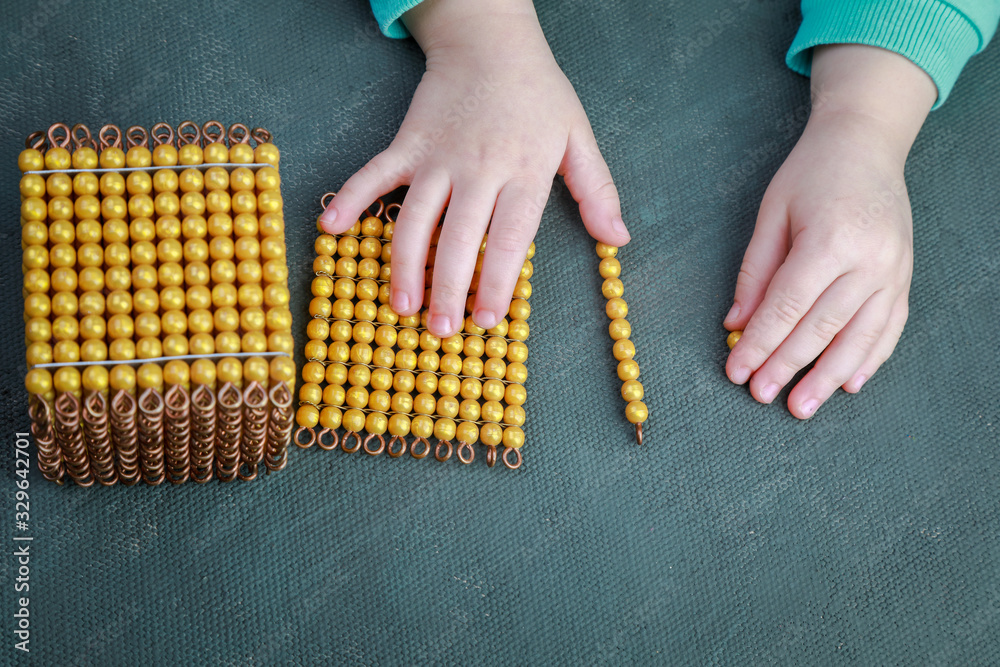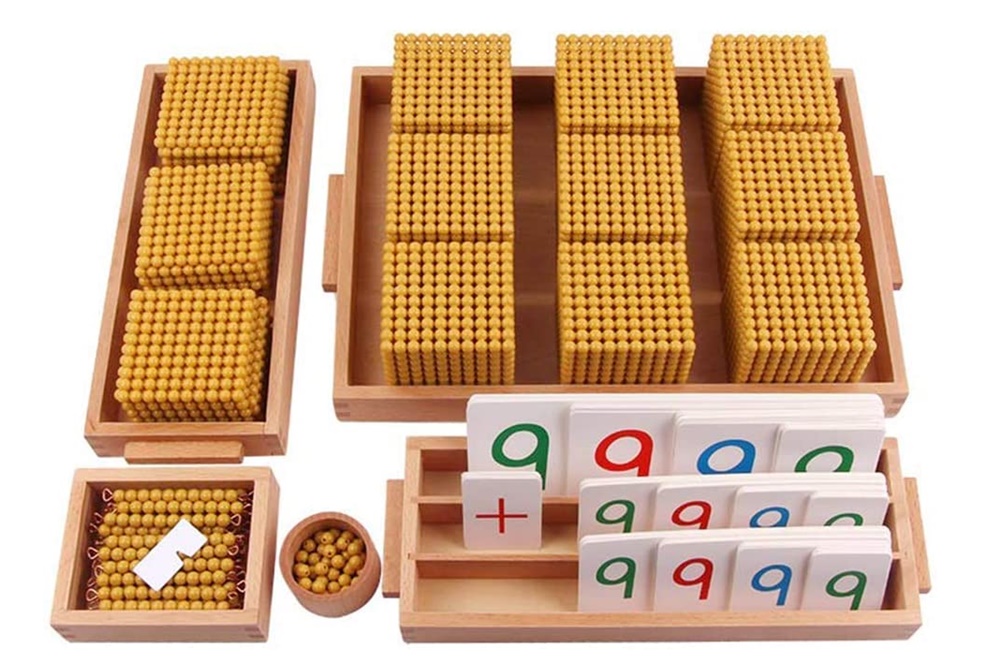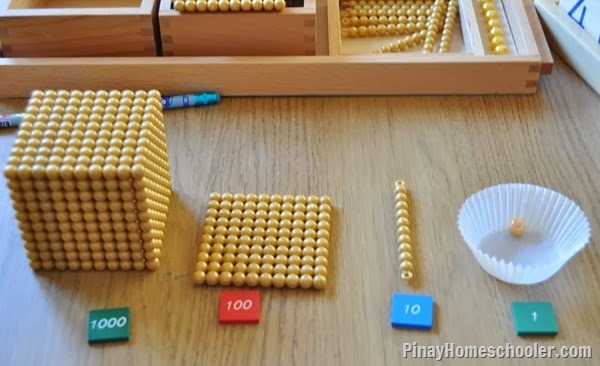Montessori decimal system “The satisfaction of discovery leads to an enthusiastic interest in numbers when the child is able to demonstrate the fundamental mathematical operation, rather than simply being told seemingly dull and meaningless facts. He physically holds the quantities that he sees represented by written symbols. He combines the material, counts, separates and compares them while visually grasping and reinforcing the ideas in a way that is concrete, rather than abstract.”
Introduction to Golden bead Material (Montessori decimal system 2024)
As evident from its name, Golden bead Material is made of golden beads of the same size. This material is used to introduce the decimal system, how it functions and the four operations i. E. addition, multiplication , subtraction and division.
The material contains units, tens, hundreds, and thousands.
- A unit is a single bead–a point.
- Ten is ten beads strung together on a wire—a line.
- A hundred 10 ten bars fastened together side by side —-a square.
- A unit of thousands is 10 hundreds fastened together to form a cube 10x10x10—-a point.
This pattern of a point, a square, repeats through the number system. When the child has a thorough understanding of the numbers 1 to 10 he can be introduced to the numbers beyond 10 using the Montessori Golden Bead apparatus.
3.1 Presentation of the Decimal system
Exercise 1: Presentation of the Decimal System
MATERIAL
- A single golden bead
- A ten bar
- A hundred square
- A thousand cube
- Preferably Dark (green) table mat
PURPOSE
- To introduce a decimal system.
- To introduce one unit, one ten, one hundred, and one thousand.
AGE 4 years onwards
EXERCISE
Note: Complete work cycle is to be observed. Montessori decimal system.
- Display the tray containing the above material in a tray on a shelf.
- Bring the material to a table with the help of the child, indicating the place on the material on the shell where it has to be returned after work.
- Spread the mat on the table.
- Place the tray on the table and start a three period lesson.
Period
- Bring the unit bead in front of the child and say “This is one unit”.
- Then show the bar of ten and say, “This is ten…one ten”.
- Then, move the square , “This is one hundred… one hundred”.
- Finally, place the cube of a thousand in front of the child and say, “This is one thousand… one thousand”.
- Having repeated the names a few times, move to period two.
Period 2
. Ask the child to show you one unit, one ten, one hundred and one thousand.
Period 3
. Point to a quantity and ask the child , “What is this?”
- The child can help himself to it, and look at it whenever he likes.

Exercise 2: Passing Nine Game
MATERIAL
- 9 unit beads
- 9 ten bead bars
- 9 hundred squares
- 1 thousand cube
- A mat
PURPOSES
- To introduce a complete Montessori decimal system.
- To give the idea that after every nine progression we must go to one of the next hierarchy,

AGE 4 to 5 years
EXERCISE
Note: Complete work cycle is to be observed Montessori decimal system .
- Bring the material to a table with the help of the child.
- Spread the mat on the table.
- Take the units and place them one by one in a vertical line in front of the child while counting each bead as one unit, two units, three units.
- Place the beads close to each other as though you are building a ten bar. Continue to place and count the remaining beads in the same way. When you reach 9 units (and there are no more units), ask the child, “What comes after nine units? “The child will probably say 10 units as he is well familiar with counting till 10.
- Show the child a bar of ten and say, ”Can you see the units on this bar of ten”. When the child says yes, ask him to count all the units in the bar of ten.
- When the child has counted the ten units in a bar of ten, tell the child, “We call ten units one ten.”
- Then begin to count the tens in the same way as units, but while counting arrange tens as if you are building a square of hundred. When you reach 9 tens (and there are no more ten bars left), ask the child, “What comes after nine tens?” The child will probably say 10 tens.
- Show the child`s a square of hundred and say, “Can you see the tens on this square of hundred”. When the child says yes, ask Hilton count all the tens bars in the square of hundred.
- When the child has counted all the tens in a square of hundred, tell the child, ”We call 10 tens one hundred.”
- Then begin to count the hundred putting them on the top of each other as if building a cube of a thousand. Ask the child to count with you. When you reach 9 hundred, ask the child the same question, “What comes after 9 hundreds?”
- When the child says ten hundreds, show him the cube of a thousand and ask if he can hundred squares of the cube of thousand.
- Ask him to count all the hundreds he can see on the cube of a thousand. When the child has counted all the hundreds in a cube of a thousand, tell the child,” We call 10 hundreds one thousand.”
- Repeat the lesson on subsequent days as long as the child is enjoying the lesson.
- Keep the material available on the shelf and allow the child to work whenever he likes.
Exercise 3: Group counting Game
MATERIAL Montessori decimal system
- 9 unit beads
- 9 ten bars
- 9 hundred squares
- 9 thousand cubes
- A tray
- 1 table mat

PURPOSES
- To further understand the decimal system.
- To enable children to count any quantity till 9999.
AGE 4 years onwards
EXERCISE
Note : Complete work cycle is to be observed Montessori decimal system.
- This should preferably be done as a group exercise.
- Invite a few children who have done the previous exercises.
- Bring the material to a table/mat with the help of the child.
- Spread the mat on the table and lay out the material in the order.
- The children stand in front of the table and the teacher at the back. The material should be in correct order facing the children.
- Being with only one hierarchy, until the children are doing the work easily .
- Put a quantity on the tray, e.g. put four hundred squares on the tray.
- Show it to the group and ask, “who can count how much is this?”
- When a child has answered correctly, put the material back on the table.
- Then put another quantity, for example 3 thousand cubes, on the tray and ask another child to count it.
- Continue the exercise in this way.
- If a child does not participate, announce while you make a number that the quantity is for “Ali” to count. Everyone else watched Ali quietly.
When the children can easily count quantities from one hierarchy separately, use quantities from more than two hierarchies. For example, and 7 hundred in the tray and ask a child to count it. Also do the extension exercise with quantities from more than one hierarchy. Continue the exercise till the children can count any quantity till 9999.
EXTENSION
Play the game in the reverse order. Say a number and ask a child to put that quantity in the tray. For example, “Who would put 4 hundreds in the tray?”
Conclusion:
In end, the Montessori decimal system does extra than educate kids about the decimal device; it unlocks the door to a global where arithmetic isn’t simply understood however embraced. This technique stands as a testimony to the strength of palms-on mastering, proving that after kids are given the tools to discover concepts in a tangible and meaningful way, their capacity for information and innovation knows no bounds. The satisfaction of discovery, rooted inside the potential to bodily manipulate and explore mathematical concepts, paves the way for a future in which kids approach mastering with curiosity, self assurance, and a deep-seated appreciation for the splendor of numbers.
